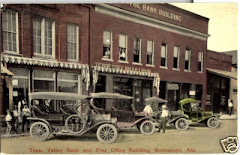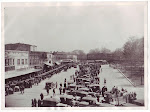 Location of French Nuclear Plants. 80% of Frances nuclear power is produced from these plants.
Location of French Nuclear Plants. 80% of Frances nuclear power is produced from these plants. TVA's Bellefonte Dream. Artists conception of Nuclear Reactor Units 1,2,3, and 4. Units 1 & 2 are currently 50% complete. Units 3 & 4 are in the planning phase and not approved either as to the reactor design or site construction. The NRC has granted a "Terminated Status" concerning the stripped Reactors of Units 1 & 2. The NRC is being sued concerning the reinstatement of construction permits that were previously cancelled. The reinstatement of the cancelled construction permits without due process violated the NRC's Atomic Licensing policy.
TVA's Bellefonte Dream. Artists conception of Nuclear Reactor Units 1,2,3, and 4. Units 1 & 2 are currently 50% complete. Units 3 & 4 are in the planning phase and not approved either as to the reactor design or site construction. The NRC has granted a "Terminated Status" concerning the stripped Reactors of Units 1 & 2. The NRC is being sued concerning the reinstatement of construction permits that were previously cancelled. The reinstatement of the cancelled construction permits without due process violated the NRC's Atomic Licensing policy. The ghostly cooling towers of Bellefonte Units 1 & 2 set idle. Approximately $4-5 billion has been spent to date in the Bellefonte project with no power being generated since construction began in the late 1970's. To complete units 1 & 2 it is estimated that costs will be from $6-8 billion at current market values. Costs are estimated at $18 billion currently for the construction of units 3 & 4.
The ghostly cooling towers of Bellefonte Units 1 & 2 set idle. Approximately $4-5 billion has been spent to date in the Bellefonte project with no power being generated since construction began in the late 1970's. To complete units 1 & 2 it is estimated that costs will be from $6-8 billion at current market values. Costs are estimated at $18 billion currently for the construction of units 3 & 4. >
Much has been said about the benefits of French Nuclear power. What is not said is the key to the rest of the story. The short of it, the French are in trouble financially over the French Nuclear program . They have placed all their "power eggs" into the "one nuclear basket" and they are being crushed by economic conditions and nuclear accidents. A truth that America's Nuclear industry is attempting to hide.
>
"The myth of a successful nuclear power industry in France has melted into financial chaos.
With it dies the corporate-hyped poster child for a "nuclear renaissance" of new reactor construction that is drowning in red ink and radioactive waste."
With it dies the corporate-hyped poster child for a "nuclear renaissance" of new reactor construction that is drowning in red ink and radioactive waste."
>
"Areva, France's nationally-owned corporate atomic facade, has plunged into a deep financial crisis led by a devastating shortage of cash." The rest of the story from "Counter Punch, America's best political newsletter." http://www.counterpunch.org/wasserman03192009.html
>
The following fact sheet was compiled by Bill Reynolds of Chattanooga, Tn., a fellow Bellefonte Efficiency and Sustainability Team Member.
"French Nuclear Power – Hidden Problems Revealed"
What you hear and see in American mainstream media about nuclear power in France is created and controlled by the nuclear industry’s powerful, extremely well-organized and well-financed “public relations” campaign. They are out to sell you as many of their extremely expensive nuclear reactors [as] our government and largest electric power corporations will buy, with money collected from you and me. Their sales campaign has effectively brainwashed many of America’s elected officials into believing such things as French-style nuclear power is clean, safe, affordable, and has solved the problems of radioactive waste. So you hear this sales message of the nuclear industry not only from the mouths of the industry’s highly skilled and highly paid salesmen and lobbyists, but also from the mouths of a lot of America’s high ranking government officials. Meanwhile, the serious and dangerous problems in French nuclear power are covered up so you do not hear about those. Only research by real experts who look for the whole truth reveals the covered-up problems and dangers. The following accounts some big problems uncovered by those experts.
· On July 8, 2008, the AREVA1 subsidiary-operated Tricastin nuclear facility in France spilled uranium into two rivers that provided drinking and irrigation water to the local communities. On July 23, at least 100 workers were contaminated during an accident at one of the four reactors at the Tricastin site. On August 6, the French nuclear security agency (ASN) announced the same facility had also emitted unacceptable levels of Carbon-14 radioactive gas throughout June and July that year.
· In August, 2003, during a severe heat wave in France, Electricite de France (EDF) 2 was permitted to discharge cooling water at such high temperatures that it kills aquatic life by cooking it.
· The high level of French standardization in reactor design increases significantly the risk of costly and potentially dangerous generic faults. A recently discovered steam generator plugging issue is only one of the latest in a series of generic safety related problems.
· Tons of radioactive waste has accumulated in the area called La Hague on France’s west coast. The earliest [that] France’s government projects they will open a permanent nuclear waste repository is 2015. [We have substantial reason to doubt the reliability of this timeline projection because, after decades of trying, neither the U.S, France, nor any other nation in the world, has developed a single permanent disposal site.]
· France discharges 100 million gallons of radioactive waste per year into the English Channel. [!!] This waste has spread all the way from there to the Arctic. Twelve of fifteen western European countries have asked France to stop discharging this radioactivity into the sea and France refuses to comply.
· France has long been extracting plutonium from spent nuclear power plant fuel rods using the so-called “reprocessing” technology. France’s reprocessing of spent nuclear fuel does NOT “recycle” the spent fuel because only about 1% of the spent fuel becomes new fuel for reactors. The other 99% remains radioactive waste that must be kept in extremely secure storage to protect the public from being harmed. (Go to http://www.ieer.org/ for further technical info about French rad waste.)
· Reprocessing extracts plutonium & uranium from spent fuel. Plutonium is the fuel in atomic and hydrogen bombs. Only one-millionth of a gram of plutonium can cause cancer. Reprocessing operations release dangerous levels of radioactivity into the surrounding environment, contaminating workers at the plants. Reprocessing creates millions of gallons of intensely corrosive acidic radioactive liquid waste.
· A significant number of France’s population have been protesting against elements of their nation’s nuclear power industry since 1987. Access to information on nuclear issues has been restricted in France. A 2007 study revealed that 59% of French citizens were in favor of a reduction of nuclear in their national energy sources. In a 2008 poll, 82% of French citizens “totally agree” or “tended to agree” with the statement “THERE IS NO SAFE WAY OF GETTING RID OF HIGH LEVEL RADIOACTIVE WASTE.”
1. AREVA, a world-leading nuclear power development corporation, is more than 90% owned by the French State. AREVA has a record of mismanagement and its financial security is plummeting.
2. EDF is the largest nuclear developer in the world. It is a French-state controlled conglomerate. EDF is the main electricity generation and distribution company in France.
"French Nuclear Power – Hidden Problems Revealed"
What you hear and see in American mainstream media about nuclear power in France is created and controlled by the nuclear industry’s powerful, extremely well-organized and well-financed “public relations” campaign. They are out to sell you as many of their extremely expensive nuclear reactors [as] our government and largest electric power corporations will buy, with money collected from you and me. Their sales campaign has effectively brainwashed many of America’s elected officials into believing such things as French-style nuclear power is clean, safe, affordable, and has solved the problems of radioactive waste. So you hear this sales message of the nuclear industry not only from the mouths of the industry’s highly skilled and highly paid salesmen and lobbyists, but also from the mouths of a lot of America’s high ranking government officials. Meanwhile, the serious and dangerous problems in French nuclear power are covered up so you do not hear about those. Only research by real experts who look for the whole truth reveals the covered-up problems and dangers. The following accounts some big problems uncovered by those experts.
· On July 8, 2008, the AREVA1 subsidiary-operated Tricastin nuclear facility in France spilled uranium into two rivers that provided drinking and irrigation water to the local communities. On July 23, at least 100 workers were contaminated during an accident at one of the four reactors at the Tricastin site. On August 6, the French nuclear security agency (ASN) announced the same facility had also emitted unacceptable levels of Carbon-14 radioactive gas throughout June and July that year.
· In August, 2003, during a severe heat wave in France, Electricite de France (EDF) 2 was permitted to discharge cooling water at such high temperatures that it kills aquatic life by cooking it.
· The high level of French standardization in reactor design increases significantly the risk of costly and potentially dangerous generic faults. A recently discovered steam generator plugging issue is only one of the latest in a series of generic safety related problems.
· Tons of radioactive waste has accumulated in the area called La Hague on France’s west coast. The earliest [that] France’s government projects they will open a permanent nuclear waste repository is 2015. [We have substantial reason to doubt the reliability of this timeline projection because, after decades of trying, neither the U.S, France, nor any other nation in the world, has developed a single permanent disposal site.]
· France discharges 100 million gallons of radioactive waste per year into the English Channel. [!!] This waste has spread all the way from there to the Arctic. Twelve of fifteen western European countries have asked France to stop discharging this radioactivity into the sea and France refuses to comply.
· France has long been extracting plutonium from spent nuclear power plant fuel rods using the so-called “reprocessing” technology. France’s reprocessing of spent nuclear fuel does NOT “recycle” the spent fuel because only about 1% of the spent fuel becomes new fuel for reactors. The other 99% remains radioactive waste that must be kept in extremely secure storage to protect the public from being harmed. (Go to http://www.ieer.org/ for further technical info about French rad waste.)
· Reprocessing extracts plutonium & uranium from spent fuel. Plutonium is the fuel in atomic and hydrogen bombs. Only one-millionth of a gram of plutonium can cause cancer. Reprocessing operations release dangerous levels of radioactivity into the surrounding environment, contaminating workers at the plants. Reprocessing creates millions of gallons of intensely corrosive acidic radioactive liquid waste.
· A significant number of France’s population have been protesting against elements of their nation’s nuclear power industry since 1987. Access to information on nuclear issues has been restricted in France. A 2007 study revealed that 59% of French citizens were in favor of a reduction of nuclear in their national energy sources. In a 2008 poll, 82% of French citizens “totally agree” or “tended to agree” with the statement “THERE IS NO SAFE WAY OF GETTING RID OF HIGH LEVEL RADIOACTIVE WASTE.”
1. AREVA, a world-leading nuclear power development corporation, is more than 90% owned by the French State. AREVA has a record of mismanagement and its financial security is plummeting.
2. EDF is the largest nuclear developer in the world. It is a French-state controlled conglomerate. EDF is the main electricity generation and distribution company in France.














3 comments:
I sure hope your lights get shut off first!!!!!!!!!!!
Obviously the BEST and BREDL types in France were quite unsuccessful. As far as oversight in France goes, it looks like they have no strict governing body like our NRC.
Unfortunately some within the NRC have become corrupted from Republican Party and Corporate interests. At least one of the Commissioners of the NRC are nothing more than a Republican operative placed there in support of Nuclear Construction interests.
France does have their NRC, it is the French Nuclear Security Agency, ASN. The French government nuclear operations is riddled with corruption, unnecessary secrecy and corporate influence not only from the private sector but from government as well.
Post a Comment